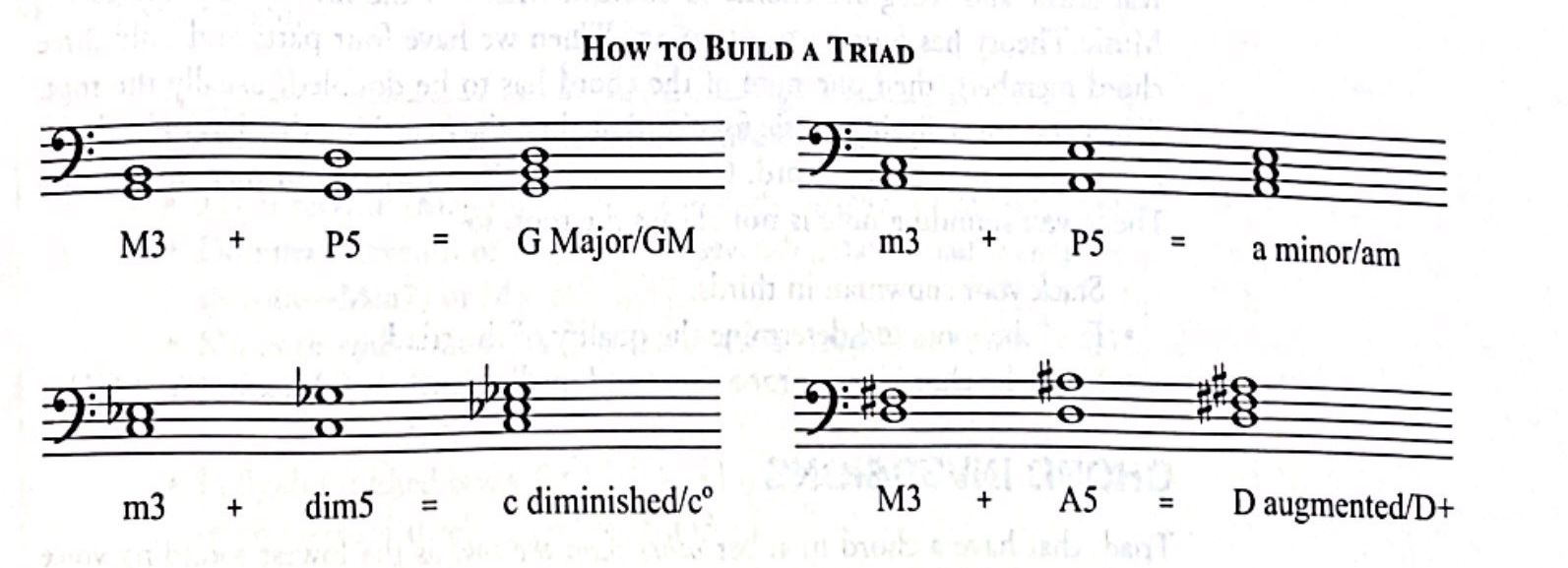Chapter 5 - Harmonic Organization 1: Intervals, Triads, and Seventh Chords
- Harmony - The way notes are simultaneously sounded, creating a vertical element to music.
- Counterpoint - A single melody line or linear voice added to another line or voice.
Intervals
- Interval - The distance between two pitches.
- They can be melodic or harmonic.
- The exact interval size is described by quantity and quality.
- Quality - Expressed by a number and determined by counting the distance between one letter name and the next letter name.
Identifying Interval Quality
- All intervals built from the tonic up to notes within a major scale are either major or perfect.
- Perfect intervals
- Unison
- Perfect fourth
- Perfect fifth
- Perfect eighth
- Major intervals
- Major second
- Major third
- Major sixth
- Major seventh
- A minor interval is one-half step smaller than major.
- Diminished interval - An interval that is one-half step smaller than perfect or minor.
- Augmented interval - An interval that is one-half step larger than major or perfect.
- Enharmonic intervals - They sound the same but are spelled differently and function differently.
- Doubly augmented interval - When a major or perfect interval is made one whole step larger without changing the letter names of the pitches.
- Doubly diminished interval - When a minor or perfect interval is made one whole step smaller without changing the letter names of the pitches.
If-Then Intervals
- If the top note is in the major key of the bottom note, then it is major or perfect.
- If the top note is a half step lower than the diatonic note would be, then it is a minor or diminished interval.
- If the top note is a half step higher than the diatonic note would be, then it is an augmented interval.
- If an interval is perfect, then both top and bottom pitches are in the other’s major key.
- If the same accidental is added to both upper and lower pitches, then the interval remains the same.
- If an accidental is added only to the bottom pitch, then the accidental has the opposite effect than when added to the note above:
- If a flat is added to the lower pitch, the interval is larger.
- If a sharp is added to the lower pitch, the interval is smaller.
- If the lower notes doesn’t represent a standard key, then determine what the interval would be without the accidental and adjust.
- Simple intervals - Intervals that are one octave or smaller in quantity.
- They are expanded to a compound interval by adding seven
- Compound intervals - Intervals that are larger than an octave.
- They are reduced to a simple interval by subtracting seven.
- Inverted intervals - Intervals are inverted by transferring the lower note an octave higher or by transferring the higher note an octave lower.
- Major intervals invert to minor intervals.
- Augmented intervals invert to diminished intervals.
- The rule of nine - When any simple interval is inverted, the sum of the ascending and descending intervals must add up to nine.
- A second inverts to a seven.
- A third inverts to a sixth.
- A fourth inverts to a fifth.
- Consonant intervals - Stable
- Dissonant intervals - Unstable, the impression of activity or tension.
- Resolution - The motion of the dissonant interval to the consonant that acts as its goal.
- Within any four-part composition, these intervals may exist:
- A-S, Alto and Soprano
- T-S, Tenor and Soprano
- T-A, Tenor and Alto
- B-S, Bass and Soprano
- B-A, Bass and Alto
- B-T, Bass and Tenor
Triads
- Chord - A group of pitches that forms a single harmonic idea.
- Triad - A three-note chord made up of two intervals stacked in thirds.
- Root - The lower note of the chord.
- Third - The middle note because it’s an interval of a third above the root.
- Fifth - The upper note, it’s a fifth above the root.
Building Triads
Tertian harmony - Harmony built on thirds.
To build a triad:
Build the snowman in thirds above the root.
Identify the quality of the lower third as a major or minor.
Identify the quality of the fifth as perfect, diminished, or augmented.
Identify the chord with the pitch name letter (the root of the snowman).
Identify the quality of the triad

